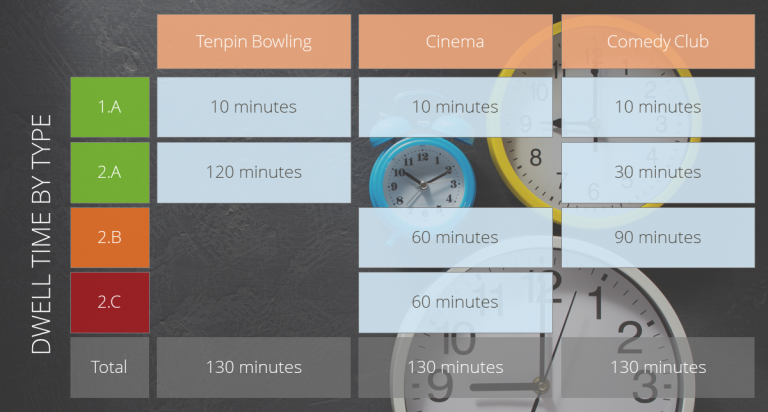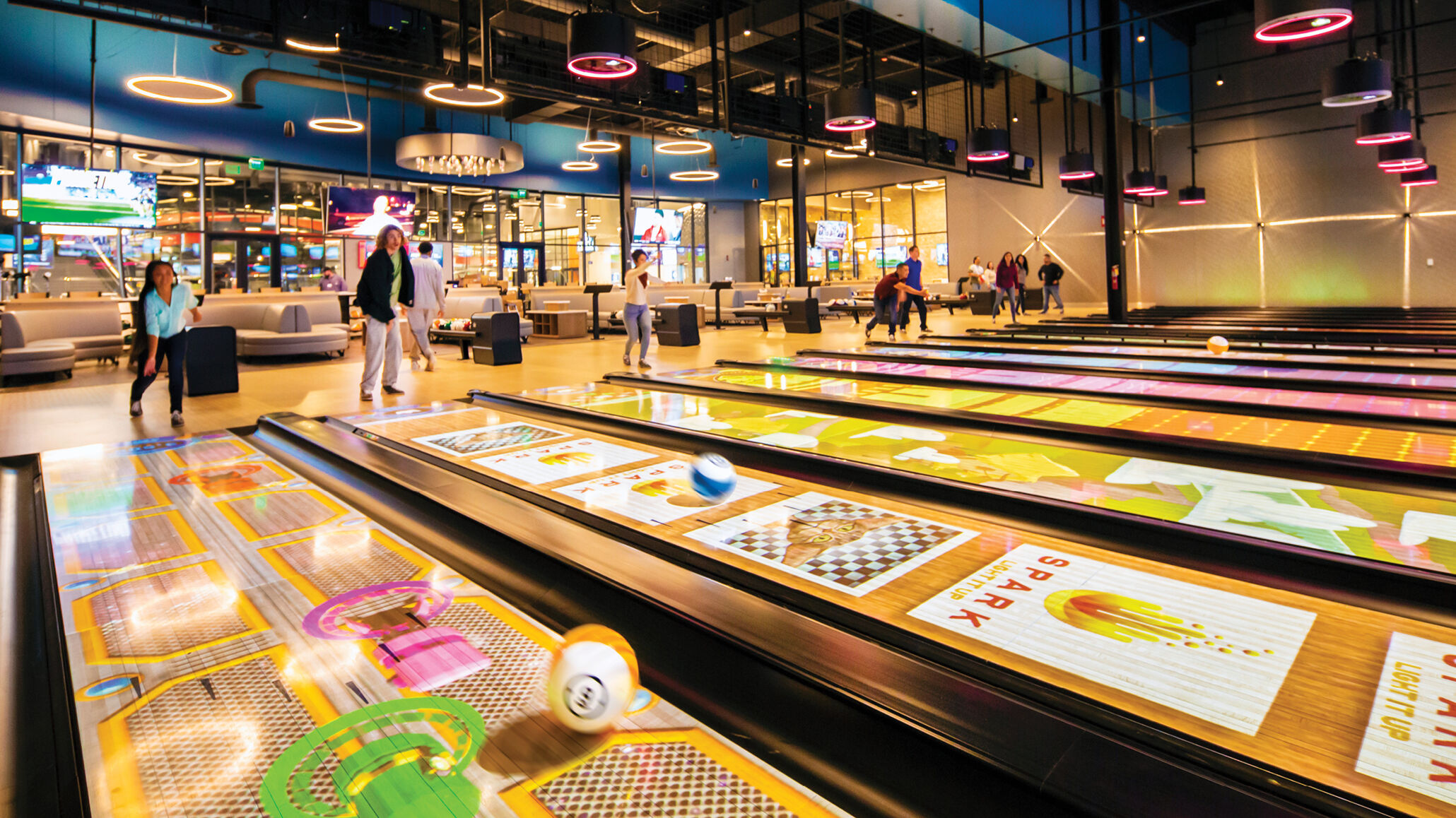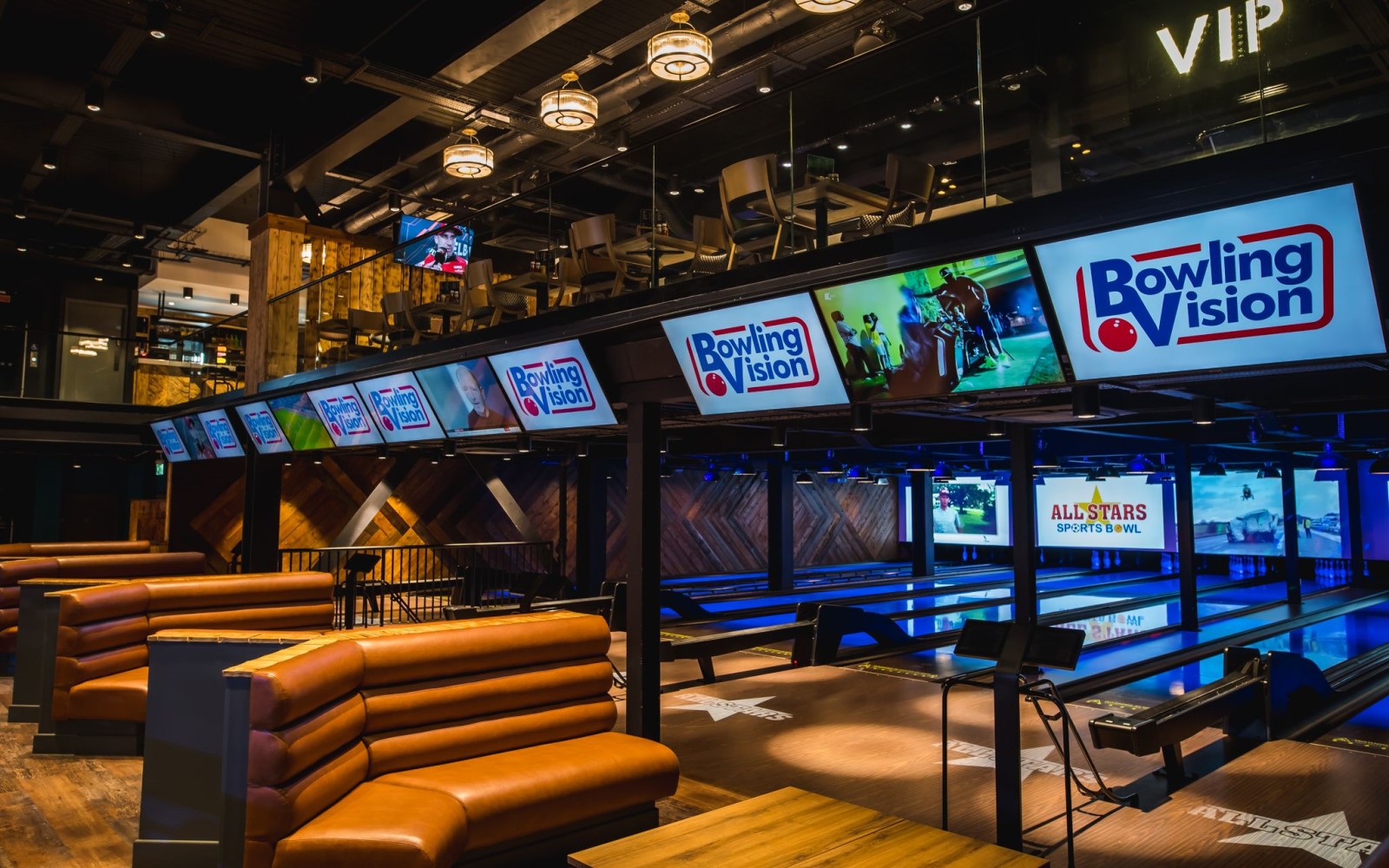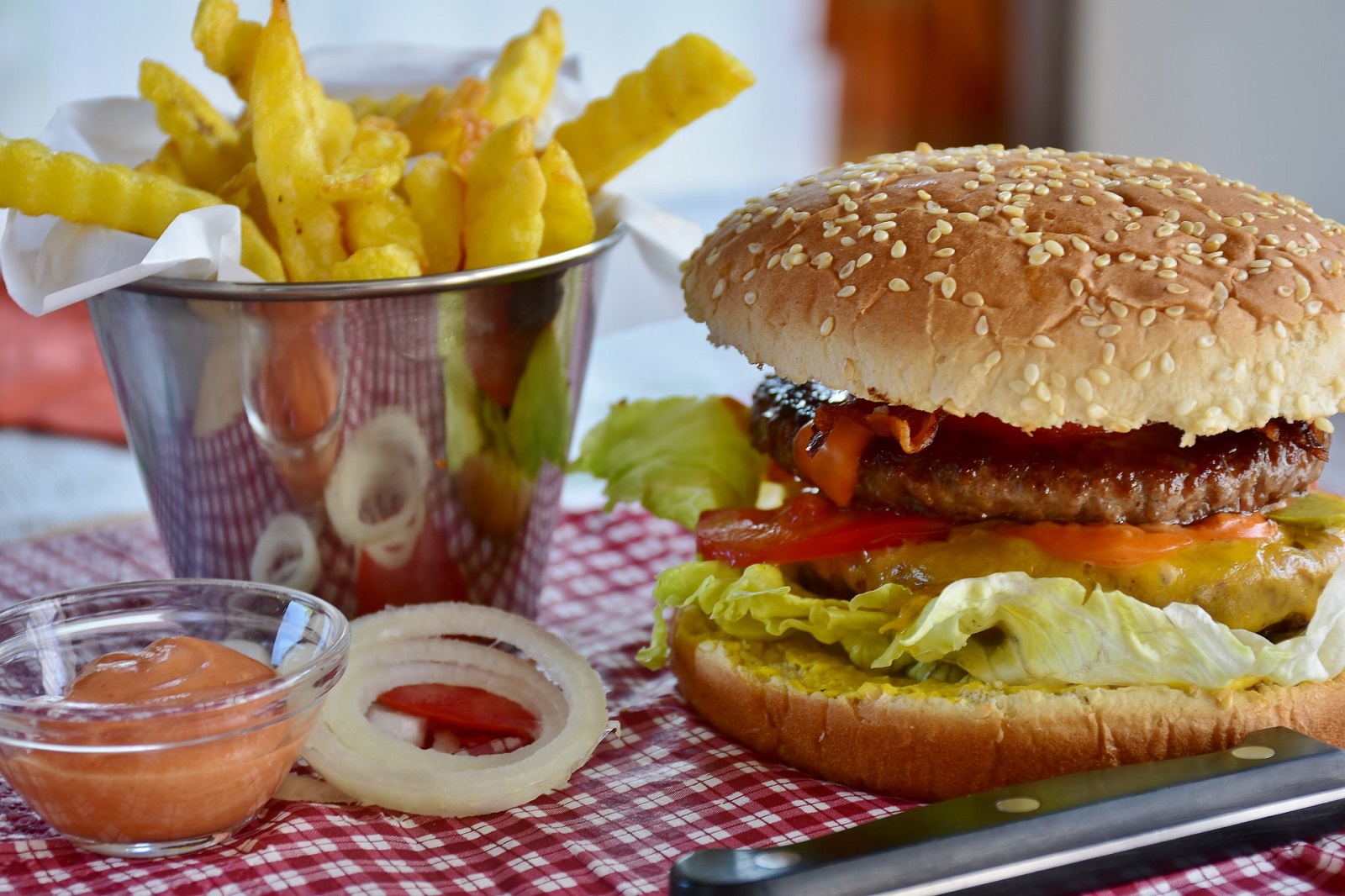Missed the start of the series? You can pick them up now – part 1 an introduction to spend per head & part 2 why SpH is important
Part 3 - Understanding Dwell Time
When we use SpH to calculate F&B revenues for new venue modelling purposes, we tend to be using benchmarked levels from existing industry data in comparable venues, so the SpH figure we have already takes dwell time into consideration.
However, when we work with a client in order to create tangible change in an existing business, or when a new concept doesn’t have a direct comparison, it’s important to look carefully at the impact of dwell time upon F&B SpH in that venue.
The concept is simple enough – if a customer is in the venue for longer, they are likely to purchase more products.
To look at this more closely, let’s take 3 example venues:
- A FEC (Family Entertainment Centre) style ten pin bowling alley
- A chain cinema
- A comedy club suitable for touring comedians
We’ll also start by assuming that the total activity time was 2 hours for each, which would break down something like the below.

We’re going to assume that the customers have booked online for an 20:00 start time, are going to arrive 10 minutes early, and then leave after they’ve finished the activity. This is representative of the normal pattern of behaviour when pre-booking an activity in most places, and gives a total time in the venue of 130 minutes.
So, if our 3 venues all have the customers in for a total of 130 minutes – that means identical dwell times, so identical Spend per Head, right?
Unfortunately, no – it would be fair to say that not all dwell time is created equally. For example, at a go kart track, when a customer is racing, they are in the venue – so they are ‘dwelling’ – but are clearly not able to purchase or consume any F&B products. Slightly differently, a customer in a theatre who is watching the show cannot leave to purchase drinks. They can consume the drinks they already purchased, but not replace them until the interval.
So, to understand how dwell time impacts SpH, we need to first categorise the different types and work out which types apply to the business in question.
Dwell Types
Initially we need to split ‘dwell time’ up into 2 distinct dwell types.
- Non-Activity Dwell Time (either before or after the activity)
- Activity Dwell Time (any time during the activity – including breaks and intervals)
Non-Activity Dwell Time can then be further split into 2 sub-types.
- Waiting time with unrestricted access to F&B – 1.A
- Waiting time with no access to F&B – 1.B
Activity Dwell Time can then be further split into 3 sub-types.
- Unrestricted purchase and consumption – 2.A
- Restricted purchase, but with unrestricted consumption of already purchased items – 2.B
- Restricted purchase and consumption – 2.C
These types are summarised in the graphic below.

1.A (Non-Activity Dwell Time) and 2.A (Activity Dwell Time with unrestricted purchase and consumption) are potentially very similar, however, 2.A very much relies upon effective service to where the activity is taking place, or at the very least incredibly conveniently placed service locations. Most venues that describe themselves as supplying ‘Competitive Socialising’ are simply using clever design of serving points combined with extensive use of skilled waiting staff to ensure that the activities they provide fit neatly in into sub-type 2.A.
The graphic below shows the breakdown of the customers’ time in our example venues by each dwell type.

To start with, each one of these venues has at least 10 minutes of type 1.A Non-Activity Dwell Time – when the customers have arrived, and are waiting for their activity to start.
Other than that, on the surface, the ten pin bowling alley is the clear winner here – 130 minutes of unrestricted purchase and consumption across a mix of 1.A and 2.A gives the greatest opportunity to sell F&B product to customers.
The comedy club does quite well, having 3 times the type 2.A dwell time, and 30 minutes more type 2.B dwell time than the cinema – due to the intervals allowing more items to be purchased for consumption during the activity.
Clearly, the Cinema suffers in terms of quality dwell time. There’s only the initial 10 minutes of type 1.A available in which to sell F&B products, and, assuming a realistic amount of time to consume these items, at least 60 minutes of type 2.C dwell time – in this case time in which no further F&B sales can be made, and there’s probably little left of the original items to consume.
So, you would therefore expect the ten pin bowling alley to return the highest SpH, followed by the comedy club, with the cinema a distant last. However, there’s more to it than that.
The Effect of Restriction - Part 1: Likelihood of Purchase
If people can only purchase F&B products for a limited amount of time, with the prospect of a long period of restriction ahead, they are more likely to attempt to purchase products whenever this window is open.
In our cinema, with the prospect of 120 minutes of no possibility of purchasing F&B items, customers are given a straight choice of buying something as they arrive, or not at all – which is a very strong incentive to decide, and therefore to buy product.
In our comedy club, the customer can purchase at any point before the show, and also in the intervals. While not quite so strong an initial incentive as at the cinema, there is still an impending restriction, so initial purchase is likely. comedy clubs then traditionally work well to encourage purchase each time the window opens again – initial acts (or sets if it’s a night with many comedians) tend to be scheduled for around 25 minutes each, and at the end of each one, the customer is encouraged to leave the performance area, and return to the bar. 25 minutes is the perfect amount of time for most customers to have finished the previously purchased drink, which means they are walking out into the place they associate with buying their first drink with no glass, or an empty glass, so are most likely to purchase another product. Comedy clubs – like theatres – also work very effectively to offer a pre-ordering facility for drinks in the intervals. This not only increases the likelihood of purchase directly, but by reducing the pressure on the bar team also gives an indirect increase to the likelihood of purchase as queues are shorter at these peak times, speeding the service offered.
Unfortunately for our bowling alley, there is ample opportunity to purchase F&B items throughout the visit, so – unless it is influenced in another way – the initial purchase isn’t encouraged to take place quickly. Equally, there are no pre-defined activity breaks to naturally signal a purchase opportunity. This situation, if not correctly managed, can lead to very low F&B spend, and is partly to blame for the very wide range of SpH seen in UK bowling centres.
The Effect of Restriction - Part 2: Price Points
Venues which restrict supply can achieve a much higher price point for each item than comparable venues. It’s the same principle as supply and demand theory in broader economics – if there’s restricted access to an item, people are happier to pay a premium to ensure access to it.
A 16oz postmix Coke is going to range in price from around £2.75 in an FEC style bowling alley, to around £3.75 in a chain cinema – an overall uplift of 36%. A similar item in a comedy club is probably going to come in at around £3.50.

The net effect of this is that in some venues, any potential variation in SpH caused by dwell time imbalance can be somewhat flattened by price increases on individual items.
It’s always worth remembering that, despite the sale price variations, the cost price is broadly going to be the same for each business. This leads to another factor which must be considered – the GP Margin % being achieved, and the final £ bottom line contribution of the revenue. Check out this article on GP Margin vs Contribution for some more info on this.
The Effect of Restriction - Part 3: Customer Arrival Time
Arenas, sports venues, theatres, comedy clubs and similar venues are notorious for slow bar service at busy times. There’s a number of reasons for this, but broadly it’s because they aren’t consistently busy on multiple nights each week – which means they don’t carry large, consistent, highly practiced staff teams – and the layout and product range is often not conducive to quick service. In isolation this is clearly going to negatively impact SpH at those times – if the bar is consistently slow at serving its customers, then obviously you’re not going to take as much money. In extreme examples, customers will just not bother buying anything at all – no-one likes waiting in line.
However, there’s an inbuilt restriction with all of these venues which isn’t present in bars, restaurants, and more family style leisure environments – such as bowling alleys, leisure centres and cinemas. Specifically, if the activity isn’t available constantly and in a wide range of other venues, it is inherently restricted. To take an extreme example, you can only see Guns n’ Roses in London a maximum of once a year, and the tickets are extremely limited. As a less extreme example, there will – outside of big cities – tend to be only one venue hosting performances by TV comedians in a given area, and the availability of tickets tends to be quite limited. As a result of these restrictions to them carrying out your desired activity, customers will naturally allow far greater leniency to annoyances like extensive queuing, and eye wateringly high prices, and will adjust their behaviour accordingly.
An interesting – and very relevant – result of this adjustment is that customers visiting these venues tend to ignore the usual behaviour of arriving 10 minutes prior to the pre-booked activity starting, instead arriving sometimes hours before. Even in small (c. 100 cap) independent comedy and live music venues, it is not uncommon for customers to arrive at least 60 minutes prior to the doors opening. Once this is considered, our dwell time breakdown suddenly looks very different.

The customers will tend to arrive at the comedy club around an hour before their activity starts, rather than 10 minutes in the case of the ten pin bowling alley and the cinema. This gives the comedy club an additional 50 minutes of type 1.A Non-Activity Dwell time. Adding this to the type 2.A dwell Time – so both instances where purchase is totally unrestricted – this gives a total of 90 minutes of time where customers can purchase product at whatever rate they want. This is only 30 minutes, or 25%, less than our ten pin bowling centre. However, there’s also another 90 minutes of type 2.B dwell time present where consumption of products can take place. Considering how the intervals are placed and the tendency for customers to purchase at arrival in comedy clubs, this actually leads to a situation where there is really only a ‘lost’ 15 minutes or so at the end of the headline acts set where consumption is restricted – the available purchase time has been really effectively maximised.
Later in this series we’ll look at how we can replicate this behavioural change in venues where the activity isn’t restricted so naturally, so that we can maximise our 1.A dwell time in any type of venue.
What is the average Spend per Head?
Clearly, there is a wide range of venue profiles within these very broad brush types, and within that wide range of venue profiles a myriad of different comparable Spend per Head data. However, a representative comparison of a FEC style ten pin bowling centre, a family focused chain cinema, and a standalone comedy club would look something like this in the same average sized town (c. 250,000 population).
FEC Style Bowling Centre – £4.50
Comedy Club – £12.50
Cinema – £2.25
Clearly, despite what initially seems to be a fairly similar ‘dwell time’, there is huge impact in the different types of dwell time offered by the different activities, and by the impacts of restriction upon the purchase likelihood, the price points achieved and the purchase frequency.
Look out for part 4 of this series (a general look at how to improve F&B SpH) on our website blog.
Originally posted by Matt Barnwell on LinkedIn






